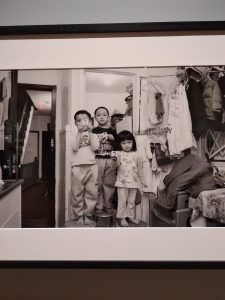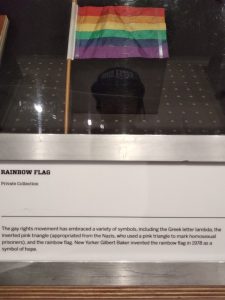On December 10th I went to the Museum of the City of NY with my class. As I’ve lived in Brooklyn my whole life, it didn’t occur to me that New York had such a rich history on so many progressive movements. I was always aware of NY’s participation on such matters, but never delved into the actual history behind these movements. Walking around the museum, I realized just how much I was missing out. The museum itself was founded in 1923 by Henry Collins Brown in an effort to preserve and showcase NY’s history to curious attendees. Various works inside, ranging from photography to books, have some sort of attachment to the history of NY. Whether the topics are on immigration or equal rights, the museum delivers a powerful and up-close encounter with history itself, making it feel as if you were right there during that era.
The first exhibit I encountered was about the entire history of New York, from its founding during the colonial times to present day metropolis. Sections of the room were split accordingly to the time period it had occurred and segments were divided via walls with texts on it. These texts served as brief summaries of said time periods, like colonists landing on America’s shores for the first time or New York becoming more diverse in the 1900s. One section that caught my eye was actually a quote I found in the colonial era. It sits above a replica of a colonist ship and some miscellaneous objects. It dawned on me that the history of NY is also a history of strife and struggle, both discriminate and indiscriminate. It is reassuring, however, to see that NY had come a long way from its colonial roots.
The second exhibit I went to was the one that featured the daily lives of Chinese American immigrants. I found this exhibit to be all around enlightening, amusing and a bit nostalgic. One picture that really struck a chord with me was this black and white photo of a family by photographer Thomas Holton. Holton had dedicated 15 years photographing this family, documenting their daily lives as Chinese immigrants. Being half Chinese himself, he never really felt a connection to his own culture. By photographing this family, he not only learned a bit of his own culture along the way, but he also portrayed the lives of Chinese immigrants in a truthful and personal manner; one that is not stereotypical.
The final exhibit I visited was the progressive movements held within NY. The section that interested me the most was the LGBTQ+ area. In it were several iconic moments documented in queer history. One such moment was the Rainbow Flag’s debut into the public. Created by Gilbert Baker, the original flag had eight stripes that included hot pink and turquoise. It was later scrapped to be six stripes due to manufacturing procedures (the colors hot pink and turquoise were difficult to replicate due to their “brightness”). Today, the six striped flag is commonly seen and embraced by the public, unlike its original debut four decades ago.







